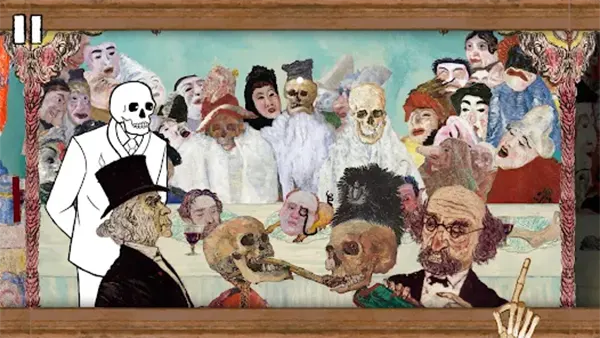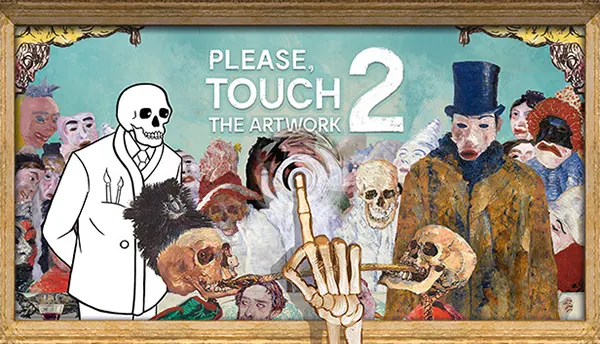In June 2025, “Please, Touch The Artwork 2” continues to stand out as one of the most original puzzle games on mobile and PC. Created by Belgian developer Thomas Waterzooi, the game merges interactive modern art with smart design and a touch of poetic storytelling. Unlike most casual games, it provokes both reflection and creativity, offering a truly atypical gameplay experience without relying on noise, gimmicks, or pressure-based mechanics.
The Artistic Foundation of the Game
“Please, Touch The Artwork 2” draws direct inspiration from the avant-garde world of modernist painter Piet Mondrian. Waterzooi reinterprets Mondrian’s abstract language, not as decoration, but as an interactive system of puzzles where art itself becomes the environment and gameplay field. With each stroke and transformation, players advance through a journey that encourages discovery and appreciation of minimalism in motion.
The game places the player in a surreal museum overrun by chaos—frames are broken, paintings are misaligned, and peculiar cats roam freely. Instead of passive observation, you are invited to interact with the artworks, fixing, rotating, and rearranging elements until harmony is restored. This metaphor cleverly reflects the idea that art is not frozen in time—it is something to be engaged with, interpreted, and sometimes repaired.
What makes the experience so unique is the emotional undercurrent that runs through the game. Despite its puzzle-based logic, “Please, Touch The Artwork 2” introduces soft narrative elements that speak to loneliness, creativity, and artistic legacy. It’s subtle, but profoundly human, and far more than a mechanical exercise.
Visual Aesthetics and Audio Design
The game’s visual style mirrors Mondrian’s iconic palette—white space, primary colours, and clean lines. Yet, Waterzooi adds his own voice, allowing elements to shift, animate, and even glitch in intentional ways. These disruptions are never jarring; rather, they invite curiosity and push the player to look closer at what they might normally ignore.
In parallel, the audio design is meditative and intentionally minimalist. Piano notes and ambient sounds accompany progress and hint at emotional states. Unlike traditional puzzle games that opt for repetition or overproduction, the audio in “Please, Touch The Artwork 2” serves as an emotional partner in gameplay, never overwhelming, always guiding.
It’s worth noting how this artistic choice stands in stark contrast to typical mobile games that flood the senses. Instead of chasing retention through overstimulation, this title encourages mindful attention and reflection. Every scene feels intentional, and every sound is precisely chosen to enhance the moment.
Gameplay Mechanics and Accessibility
The game introduces several distinct puzzle modes, each tied to different artworks and logical systems. Some puzzles require spatial rotation, others rely on timing, while some demand an understanding of symmetry. Yet the rules are never frustrating; each mechanic is introduced organically, with no need for complex tutorials or hand-holding.
What’s especially remarkable is the approachability of the game. There’s no punishment for mistakes, no time limits, and no scoring system. Instead, progress is measured by how deeply you engage with the puzzles and art. This encourages experimentation, making the game suitable for players of any age or skill level.
In 2025, the accessibility design has been further refined. The latest updates include full controller support, colourblind-friendly modes, and gentle hints that maintain immersion without disrupting gameplay. This commitment to inclusivity has been praised by both critics and accessibility advocates alike.
Interaction with the Museum Environment
The game world is structured like a fictional museum, with interconnected rooms that evolve as players solve puzzles. These rooms are not only spaces to explore but also part of the gameplay logic. Items can be collected, interactions remembered, and progress feels persistent and rewarding.
One standout feature is the recurring appearance of a mysterious cat, whose behaviour often hints at solutions or reveals hidden secrets. This subtle guidance system adds charm and personality to the game world, making it feel more alive and unpredictable.
Additionally, each completed puzzle restores a part of the museum’s gallery, allowing players to appreciate the artworks they’ve “repaired” as part of a larger collection. This museum-building loop creates a satisfying narrative arc from chaos to order, enhancing replayability without artificial extension.

Developer Vision and Player Reception
Thomas Waterzooi’s intent with “Please, Touch The Artwork 2” is not to chase mass appeal but to explore the emotional and educational value of art in gaming. His background in both fine art and interactive design gives the game a distinctive voice and purpose. This is a personal project rooted in curiosity, restraint, and genuine affection for artistic expression.
Since its release, the game has received highly positive reviews across both mobile stores and PC platforms. Critics consistently praise its originality, elegance, and intellectual depth. Players, too, report that the game helps them relax, think differently about art, and reconnect with a sense of play often missing from digital experiences.
Community engagement continues to grow, particularly around speedrun attempts and puzzle mods. Waterzooi has even expressed interest in releasing a content creation toolkit to allow players to develop their own levels based on abstract artworks. This would be a significant step in blending gaming and art education.
Legacy, Longevity, and Cultural Value
“Please, Touch The Artwork 2” is more than just a sequel—it’s a continuation of a philosophy. It defies commercial trends by focusing on craftsmanship and meaning, rather than volume and reward systems. In a marketplace increasingly driven by engagement metrics, this game stands apart.
Its contribution to the conversation around games as art is especially important. It doesn’t preach or explain—it simply is, and that quiet confidence has earned it admiration from both gaming communities and art institutions. Some museums have even included the game in interactive exhibitions on digital art in 2025.
Whether you approach it as a puzzle fan, an art enthusiast, or someone curious about new forms of storytelling, “Please, Touch The Artwork 2” offers a sincere and memorable experience. It reminds us that games can be thoughtful, beautiful, and worthwhile without ever needing to shout for attention.

